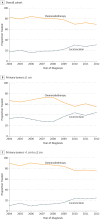Management of Stage I Squamous Cell Carcinoma of the Anal Canal
- PMID: 29049547
- PMCID: PMC5885927
- DOI: 10.1001/jamasurg.2017.3151
Management of Stage I Squamous Cell Carcinoma of the Anal Canal
Erratum in
-
Error in Presentation of Author's Name.JAMA Surg. 2018 Jul;153(7):692. doi: 10.1001/jamasurg.2018.1624. Epub 2018 May 23. JAMA Surg. 2018. PMID: 29799919 Free PMC article. No abstract available.
Abstract
Importance: The incidence of squamous cell carcinoma of the anal canal (SCCAC) is increasing. Although standard management of SCCAC includes the use of concurrent chemotherapy and radiotherapy (chemoradiotherapy), data are lacking on potentially less morbid, alternative management strategies, such as local excision, among patients with node-negative T1 disease.
Objectives: To examine the use of local excision among patients with T1 SCCAC and to compare overall survival relative to those who received standard treatment with chemoradiotherapy.
Design, Setting, and Participants: This retrospective cohort study assessed 2243 patients in the National Cancer Database (2004-2012) between 18 and 80 years of age with T1N0M0 SCCAC. The association between the type of treatment received and overall risk of death was evaluated using multivariable Cox proportional hazards regression models. Data analysis was performed from June 29, 2016, to April 17, 2017.
Main Outcomes and Measures: Overall survival.
Results: Among 2243 patients with T1N0 SCCAC, 503 (22.4%) were treated with local excision alone (mean [SD] age, 54.5 [12.1] years; 240 [47.7%] male; 419 [83.3%] white) and 1740 with chemoradiotherapy (mean [SD] age, 57.0 [10.6] years; 562 [32.3%] male; 1547 [88.9%] white). Among those treated with chemoradiotherapy, 12 patients underwent a subsequent abdominoperineal resection. There was a statistically significant increase in the use of local excision during the study period (34 [17.3%] in 2004 to 68 [30.8%] in 2012; trend test, P < .001). This increase in use was observed among patients with primary tumors that measured 1 cm or smaller and greater than 1 cm to 2 cm or smaller (trend test, P < .001 for both). Overall survival at 5 years was not significantly different for the 2 management strategies (85.3% in the local excision cohort and 86.8% in the chemoradiotherapy cohort; log-rank test, P = .93). Overall risk of death was not significantly different for local excision alone relative to that for treatment with chemoradiotherapy (hazard ratio, 1.06; 95% CI, 0.78-1.44). These findings were robust when stratified by tumor size and when patients who underwent abdominoperineal resection after chemoradiotherapy were excluded.
Conclusions and Relevance: The use of local excision alone for the management of T1N0 SCCAC has significantly increased over time, with no clear decrement in overall survival. Because local excision may represent a lower-cost, less morbid treatment option for select patients with SCCAC, future studies are needed to better delineate its role and efficacy relative to the current standard of chemoradiotherapy.
Conflict of interest statement
Figures



Comment in
-
Limitations of the National Cancer Data Base to Evaluate Early-Stage Anal Cancer Treatment Outcomes.JAMA Surg. 2018 Jul 1;153(7):691. doi: 10.1001/jamasurg.2018.0394. JAMA Surg. 2018. PMID: 29710110 No abstract available.
-
Limitations of the National Cancer Data Base to Evaluate Early-Stage Anal Cancer Treatment Outcomes-Reply.JAMA Surg. 2018 Jul 1;153(7):691-692. doi: 10.1001/jamasurg.2018.0400. JAMA Surg. 2018. PMID: 29710204 No abstract available.
-
Limitations of the National Cancer Data Base to Evaluate Early-Stage Anal Cancer Treatment Outcomes.JAMA Surg. 2018 Jul 1;153(7):690-691. doi: 10.1001/jamasurg.2018.0391. JAMA Surg. 2018. PMID: 29710345 No abstract available.
References
-
- Surveillance, Epidemiology, and End Results. Stat fact sheets: anal cancer. http://seer.cancer.gov/statfacts/html/anus.html. Published 2015. Accessed April 12, 2017.
-
- Glynne-Jones R, Renehan A. Current treatment of anal squamous cell carcinoma. Hematol Oncol Clin North Am. 2012;26(6):1315-1350. - PubMed
-
- Nigro ND, Vaitkevicius VK, Considine B Jr. Combined therapy for cancer of the anal canal: a preliminary report. Dis Colon Rectum. 1974;17(3):354-356. - PubMed
-
- National Comprehensive Cancer Network. NCCN Clinical Practice Guidelines in Oncology (NCCN Guidelines). Anal carcinoma. http://www.nccn.org/professionals/physician_gls/pdf/anal.pdf. Accessed March 20, 2017.
-
- Doyen J, Benezery K, Follana P, et al. . Predictive factors for early and late local toxicities in anal cancer treated by radiotherapy in combination with or without chemotherapy. Dis Colon Rectum. 2013;56(10):1125-1133. - PubMed
Publication types
MeSH terms
LinkOut - more resources
Full Text Sources
Other Literature Sources
Medical
Miscellaneous

